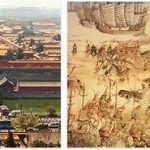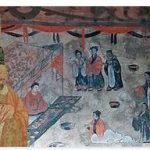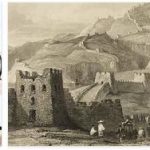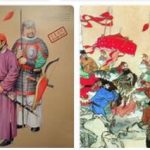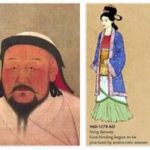The entry Libya derives from the name of one of the ancient populations of Cyrenaica, which is not known to us directly from indigenous sources, but only through the testimonies of other peoples (Egyptians, Jews, Greeks, Carthaginians) who knew about it or came with it to contact.
In Egyptian documents from the end of the 3rd millennium BC. C., and especially from the 2nd millennium, the name Rbw, Lbw appears, probably pronounced Lebu or Libu, and referring to an ethnic branch or group of tribes residing in the finitime areas west of the Nile valley. If we keep in mind the types of Berber names of populations and places that are found in large numbers in medieval and modern documents and widespread in regions even very distant from each other, such as between Cyrenaica and Morocco, and which therefore must go back to a remote origin, it is very likely that the term Lebu in the indigenous form was a plural (Ilibuen) or rather a composition with At, Ait o Kel (At Lebu, o Kel Lebu).
Through the Egyptians or the Phoenicians the Hebrews knew the name, which appears in Genesis (X, 13) in the form Lehabim, and in more recent writings of the Bible (Chronicles, II, 12, 3; 1698; Daniel, II, 43, etc.) in the forms L ū b ī m and Lub ī m. They are Hebrew plurals; they are matched by the name Lwbym = Libi, which appears in a Neopunic inscription found in Tripolitania, and the sing. Lby male and female. Lbt (pronounced Lib ī, Libet, o Lub ī, Lubet) found in Punic inscriptions from Tunisia. It is probable that these names used by the Carthaginians dated back to the geographical knowledge of the ancient Phoenicians.
But those who introduced and widely spread the ancient name of the Cyrenaic people in the Mediterranean cultural world were the Greeks, who adopted the term Λυβύη to indicate the region and Λίβυες for the population. They knew this for the first time either through the Egyptians or directly and perhaps before the beginning of the Doric colonization of the century. VII a. C. (see Cyrenaica), since relations between Cyrenaica and the Aegean world must have existed in a much more remote period. By Hellenizing the name, the Greeks forgot its origin and formed myths and legends to explain it, such as that of the indigenous woman called Libya, who would give the region its name. The first mention of Libya is found in the Odyssey (IV, 85), where it is described as rich in flocks and is remembered alongside other names of regions and peoples of a certain importance, such as Phenicia, the Egyptians, etc.; from which it seems possible to deduce that the term did not refer to the simple land of the Lebu, but with a first expansion of the meaning of the name, to an area of northern Africa including Cyrenaica and part of Tripolitania or all of this. Soon, namely in the century. Street. C., from the Ionian geographers referred to by Herodotus (II, 16) the name Libya it acquires a much broader meaning: that is, it refers to the entire known or supposed African continent; and this sense generally retains among the Greeks, even though some argue whether the border with Asia was the Nile or the Red Sea, and even though it came in some period and by some writers applied to single parts of Africa, such as for example., to the northern area which was then called Barberia, or to the Roman province of Africa.
The name of the nations, Λίβυες, Libyans, had meanings in part independent from that of the region. With Herodotus it already designated the white populations of North Africa (later called Berber), as opposed to the Ethiopians, that is, the Negro or Negroid peoples of the Sahara and Sudan. But with some Greek writers it has an even narrower meaning, referring to the indigenous people who lived in the territory of direct dominion of Carthage, corresponding almost to the northern half of Tunisia. In Roman times other names came into use (Afri, Africa, etc.); however the name Libya, Libye it was also used by some Latin writers. Memories of it are found in Arab geographers and historians, alongside the new special designations that spread widely with the Muslim conquest of North Africa (see Berbers). Even in Europe, during the Middle Ages and the modern era, the name Libya reappears with variety of applications, such as eg. with Leone Africano and others who refer him to the Great Desert; until nowadays, officially adopted by Italy to indicate Cyrenaica and Tripolitania together, it almost coincides with that which results from Homer.
As for the ethnic name Libî, Libyan, etc., today’s European scientific use refers it to the indigenous population inhabiting northern Africa in the ancient period; while the other term Berberi, widespread after the Arab conquest and Islamization, is properly used to indicate the indigenous element descending from the ancient Libîs, that is, not Arab, in its medieval and modern period. However, some use the latter also to designate the Libîs; others extend the first to today’s Berbers, giving it a special meaning of originality, of conservation, even through the superimposition of other peoples and civilizations, of somatic characters and moral qualities. And in fact the history of Northern Africa presents itself to us from its beginnings up to the present day as a story of relationships that are established between the Libyan population inhabiting the African coastal strip from the western borders of Egypt to the Atlantic, and a series of peoples and civilizations coming from Europe or Asia, which settle in those vast areas and carry out their work there: the mixing of the indigenous element with these peoples, the influences it undergoes, its reactions, its sometimes fortunate attempts to found, among one domination and the other its independent states, its preservation in part intact through three millennia; all this constitutes a complex series of events which, taking place in the middle of the Mediterranean, are of the highest interest, including political ones.Berbers ; for more detailed information about individual regions, periods, dynasties, see algeria: Libyan Antiquities; almohadi ; almoravidi ; ḥammaditi ; morocco, etc. For Libya religion and languages, please check ezinereligion.com.
Only the conclusions to which the most recent studies have led in detecting the characteristics of these events and in judging the part that the North African indigenous mass, occupying almost the entire southern edge of the Mediterranean, played in the history of this basin are exposed here. it was the cradle and center of the world’s civilization. In this regard, several scholars have pronounced completely unfavorable judgments, such as, for example, Augusto Mu̇ller, who declares that the Berbers are a race by nature adverse to civilization and unable to keep up with any intellectual progress; and Leone Caetani, who defined them as nomads, extremely turbulent, rebellious to any external influence, averse to any improvement in their own moral condition. Other historians and geographers have exalted the Berbers, from Ibn Khaldūn who put them together with the great peoples of history, to the German geographer Teobaldo Fischer, who in his study of the Mediterranean peoples and their place in world politics, published for the first time in 1907, dealt at length with the Berbers, describing them with sympathy attitudes and facts and saying, among other things, that they had a great political and cultural importance in the Arab Middle Ages, and likewise will have it in the future. But the numerous linguistic, historical and ethnographic investigations carried out in the last twenty years have given a much deeper knowledge of North Africa, which through a series of successive stratifications of civilizations presented itself as an extremely confused area of study. First of all, it was possible to identify quite clearly, in the midst of complex foreign influences, a Libyan-Berber civilization, with its social arrangements, religious and magical beliefs, its own writing, construction methods, agriculture, household furnishings, etc. Evaluating these manifestations as a whole, it can be seen that if they do not coincide with those of peoples in a state of nature, they must not even be completely ascribed to the category of civilians: rather they are part of the cultures that are used to call semi-civilians. On the other hand, it is clear from North African history that in the periods in which indigenous states of a certain entity are formed and artistic and literary currents of a certain splendor are established, there is always a graft of some other civilization imported into North Africa and that it constitutes like the leaven of a superior form of life. So in the reign of Massinissa, in which the traces of Punic and then Roman civilization are evident; in that of Giuba II, with the capital Caesarea, rich in Hellenic and Roman influences. The spread of the great Latin civilization attracted indigenous groups and characters to its orbit who, entirely Romanized, also had state functions and high offices. Christianity shone with vivid splendor in North Africa and had great theologians, masses of fervent believers and distinguished martyrs, among whom very many were wholly or partly of indigenous lineage. With Islamization, Arab culture spread to the Berber world and took part in the formation of several states, some of which had heads of Arab origin and masses of Berber subjects, others were entirely Berber. An admirable architecture, sacred and profane sciences were cultivated by indigenous people who found impulses for new spiritual developments in the language and religion of the Koran. From a long series of similar events that begin with the Libyan family which, transplanted into Egyptian soil, at the beginning of the first millennium BC. C., obtained the supreme power and constituted the XXII dynasty, and reaching up to our days, the fundamental characteristic of the Libyan-Berber people from the social point of view is noted, that is their inability, where they are left to themselves, to progress beyond the first steps of civil life, while framed in a civilization already in full development, they can absorb it completely, if not definitively, and make splendid contributions to its maintenance and further progress, no less than those of the lineages that created it. Far more than many other races, the Berbers show a tendency to model themselves on imported civilizations; the results of history find confirmation, in this regard, in the direct examination, which we can do in our day, of some groups and especially in the evolution undergone by individuals transplanted to Europe and on their way to our studies. Even in evil the influences of others are profoundly affected, as can be seen by comparing the splendid Roman period with that of the Vandalism and that of the Barbarian regencies, during which the latter the North African coastal populations showed developed piratical attitudes. Due to these characteristics it is easy to see the importance of the problem facing Europe: of an indigenous mass, that is, which once belonged to the Mediterranean spiritual life and which was then attracted to the orbit of the East will be able to return to our civilization, where the colonizing nations know how to influence its natural tendencies by drawing inspiration from high ideals. It is singular that the conclusions of modern scholars on the attitudes of the Berbers towards civilization are already foreshadowed in an operetta by Abbot Antonio De Torres, printed in Venice in 1789 and entitled Numidian literature.
For the political and cultural history of the region, see. cyrenaica ; Italian – Turkish, war ; tripolitania.


